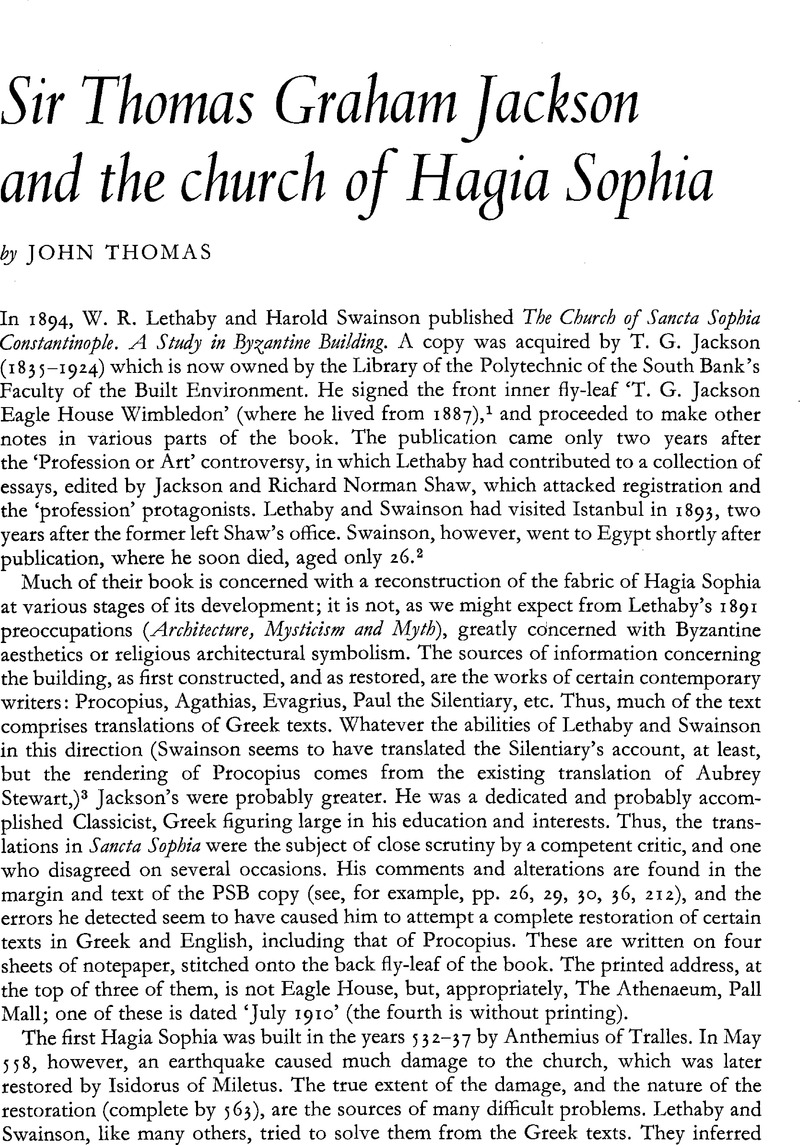Article contents
Sir Thomas Graham Jackson and the church of Hagia Sophia
Published online by Cambridge University Press: 11 April 2016
Abstract

- Type
- Other
- Information
- Copyright
- Copyright © Society of Architectural Historians of Great Britain 1982
References
Notes
1 Unfortunately, this detached damaged sheet has now been lost, but these details were noted by the author prior to this.
2 See The Builder, 5 January 1895, p. 14 (obituary).
3 In 1905, Lethaby published two articles on Hagia Sophia (The Architectural Review, January-June 1905, 17, pp. 118–24; 147–53). The first makes use of the Silentiary’s poem, in quotation and précis, based on ‘the translation of Mr. H. Swainson’ (n. 3, p. 122); actually, the sentence quoted has been slightly altered from that in the book. These articles were clearly occasioned by the production of detailed measured drawings of the building (pp. 120,121), and sketches, by J. B. Fulton, several of which are dated July 1903. Lethaby adds no new facts, avoids problems, and concentrates on the decorations.
4 Lethaby and Swainson were sceptical of the supposed measurements of the height of the dome, given by certain literary accounts, which implied an impossibly low structure. So, they suggested a slightly higher dome (fig. 14, p. 31; and text pp. 209, 210, which surely confuses curves B and c).
5 In November of 1894, Bentley went abroad in search of Byzantine inspiration for his cathedral at Westminster. Spending several months in Italy, he attempted, in February 1895, to reach Istanbul, only to be deterred by the outbreak of cholera there. He did study Hagia Sophia however, but at secondhand, from Lethaby and Swainson’s book (which he seems to have carried with him): ‘San Vitale at Ravenna and Lethaby’s book really told me all I wanted’ (W. de l’Hôpital, Westminster Cathedral and its Architect, Hutchinson, N. D., 1, p. 35). He returned home on 7 March.
6 The Recollections of Thomas Graham Jackson 1835–1925, edited by B. H. Jackson (his son), (Oxford University Press, 1950), p. 270. Much additional information for this article has been taken from this work.
7 This refers to the buttress controversy. Salzenburg considered the great buttresses, which stand beside the lateral arches, to have been added, or at least added to, at the restoration. Lethaby and Swainson, following Choisy, considered the buttresses to be part of the original design. They suggest that they were extended in width, not height, and this means the addition of the (outer) staircases. But Jackson writes: ‘There were found at the time of my examination to be clean joints between stair turret and the rest of pier [i.e. buttress]’. So, in his 1913 book he suggests that ‘If Justinian at this time added to them it must have been in the upper part only …’ (p. 90, see also 91).
8 23 March 1895, pp. 213–16; 30 March 1895, pp. 233–35.
9 Godfrey Rubens, however, in his introduction to the 1974 reprint of Architecture, Mysticism and Myth, does not mention the book, while stating that the 1891 work was important to the Byzantine Revival (p. xiii). Sancta Sophia’s significance in the history of British architecture, then, has not been fully acknowledged. We have seen (note 5) that the book influenced Westminster Cathedral, the greatest product of the fin de siècle Byzantine taste.
10 See Sir Charles Nicholson and Charles Spooner, Recent English Ecclesiastical Architecture, Technical Journals, N.D., pp. 146–50.
- 1
- Cited by


